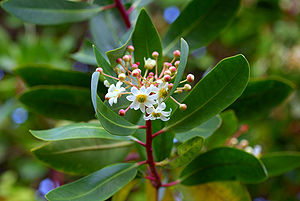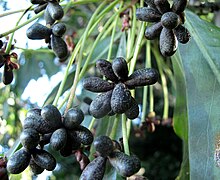Winteraceae
| Winteraceae | ||||||||||||
|---|---|---|---|---|---|---|---|---|---|---|---|---|

|
||||||||||||
| Systematics | ||||||||||||
|
||||||||||||
| Scientific name | ||||||||||||
| Winteraceae | ||||||||||||
| R.Br. ex Lindl. |
The Winteraceae are a family of plants in the order Canellales within the Magnoliids (Magnoliids). It is mainly characterized by the absence of tracheas and many features are original.
description





Appearance and trunk
The Winteraceae are woody plants and grow evergreen trees and shrubs . The nodes are bilacunar with three leaf tracks, possibly trilacunar. An internal phloem is present. An important characteristic of the family is that they have no tracheas in the xylem . The sieve-tube plastids belong to the S-type.
leaves
The alternate and spiral, seldom almost whirled on the branches arranged leaves are divided into petiole and leaf blade. The soft-leaved to leathery, simple and entire leaf blade has pinnate veins and glands, but no hairs ( trichomes ). The stomata are paracytic. The mesophyll contains round cells with essential oils , which gives the leaves an aromatic scent. There are sklerenchymatic idioblasts in the mesophyll . The minor leaf veins have no phloem transfer cells.
Inflorescences and flowers
The flowers are solitary or in zymose inflorescences . Most species have hermaphroditic flowers.
The flowers are medium in size. The flower envelope is divided into a calyx and a crown. The two to four, rarely up to six sepals stand in a circle, which are at least partially fused and form a kalyptra (flower cap). The seldom two or mostly five to 50 petals stand in one to three circles; those of the outermost circle are sometimes partially grown together.
The stamens are free in two to five circles. They are applied centripetally, but mature centrifugally. There are 15 to 100 stamens, all of which are fertile. They are often flat, less often thread-like. The anthers ( anthers ) are adnat and open with a longitudinal slit. The anther wall has two to four cell layers. The pollen is scattered in aggregates or individually, usually in tetrads. The pollen grains are monoporate or trichotomocolpat, and two-celled.
The gynoeceum consists of (one) three to twenty carpels in a circle of flowers. You are on top. The carpels are completely or incompletely closed. Usually the carpels are not fused together (apocarp), but can also be fused together (synkarp). A stylus can be formed. One to 100 ovules per carpel are formed in marginal or dispersed placentation . When fused carpels consisting ovary of two to 20 trays, and also has many scars , as well as a to 50 ovules per subject.
The ovules are anatropic, bitegmic and crassinucellate. The embryo sac corresponds to the Polygonum type. The polar nuclei fuse before fertilization . The three antipodal cells are retained. The endosperm is cellular.
fruit
There are berries or fruit capsules formed. It can be collective crops. The endosperm is smooth and oily. The embryo is well differentiated but very small.
ecology
The pollination is carried by the wind ( anemophily ) or by insects ( Entomophilie ).
ingredients
Pro anthocyanidins , cyanidin and flavonols occur regularly. Cyanogenic glycosides and alkaloids are partly present. Iridoids and ellagic acid are absent.
Systematics and distribution
The Winteraceae family was founded in 1830 by Robert Brown ex John Lindley : An Introduction to the Natural System of Botany. 26 set up. The genus Wintera, which gives the family its name, is incorporated into Drimys . The genus name Wintera Murray is an illegitimate name for Drimys J.R. Forst . & G.Forst.
The Winteraceae R.Br. ex Lindl. nom. cons. is divided into the two subfamilies Taktajanioideae Leroy (Syn .: Takhtajaniaceae J.-F. Leroy ) and Winteroideae Arnott (Syn .: Wintereae Meisn. , Drimyidoideae Raf. , Drimyideae Baill. , Exospermeae Hutch. , Temoideae Raf. ,).
The Winteraceae thrive in temperate to tropical areas, especially in the mountainous regions of the tropics. They can be found from Malaysia to the Pacific, in eastern Australia and New Zealand, but also in Central and South America, as well as Madagascar.
There are four to seven genera in the Winteraceae family, depending on the source. According to Kew Gardens there are the following five genera:
-
Bubbia Tiegh. : It contains only one species, which is also placed under Zygogynum :
- Bubbia howeana (F. Muell.) Tiegh. : It occurs only on Lord Howe Island east of Australia.
-
Drimys J.R. Forst. & G.Forst. (Syn .: Wintera Murray ): Depending on the author, there are 9 to 21 species. The approximately 5 to 14 Asian species are often classified as a separate genus Tasmannia R.Br. ex DC. separated from the other South American Drimys species. To Drimys belongs:
- Drimys andina (Rich) RARodr. & Quezada : It occurs in Argentina and Chile.
- Drimys granadensis L. f. : It occurs in southern Mexico, Guatemala, Honduras, Costa Rica, Panama, Colombia and Peru.
- Winter bark ( Drimys winteri J.R.Forst. & G.Forst. ): It is common in Chile and Argentina.
-
Exospermum Tiegh. : It contains only one type:
- Exospermum stipitatum (Baill.) Tiegh. : It occurs in New Caledonia.
- Pseudowintera Dandy : The three to four species occur in New Zealand.
-
Takhtajania Baranova & J.-F. Leroy : It is sometimes placed in its own subfamily Takhtajanioideae J.-F.Leroy or even a separate family Takhtajaniaceae (J.-F.Leroy) J.-F.Leroy . It contains only one type:
- Takhtajania perrieri (Capuron) Baranova & J.-F. Leroy : It occurs in Madagascar.
-
Tasmannia R.Br. ex DC. : The three or so species occur in Australia. Some authors also consider them to be Drimys . Including:
- Tasmanian mountain pepper ( Tasmannia lanceolata (Poir.) ACSm. )
- Zygogynum Baill. : The sixor sospecies are distributed from New Guinea to New Caledonia .
Sources and further information
The article is mainly based on the following web links:
- Winteraceae on the AP website . (Sections Systematics and Description) Last viewed on 2020-03-01.
- Winteraceae in L. Watson and MJ Dallwitz (1992 onwards): The families of flowering plants . (Section description)
Individual evidence
- ↑ a b c d e Winteraceae on the AP website .
- ↑ a b Data sheet at Plants of the World online from the Board of Trustees of the Royal Botanic Gardens, Kew . Last viewed on 2020-03-01.
- ↑ Winteraceae at Tropicos.org. Missouri Botanical Garden, St. Louis, accessed March 1, 2020.
- ↑ a b c d Winteraceae in the Germplasm Resources Information Network (GRIN), USDA , ARS , National Genetic Resources Program. National Germplasm Resources Laboratory, Beltsville, Maryland. Retrieved March 1, 2020.
- ^ JLR Every, 2009: Neotropical Winteraceae. In: W. Milliken, B. Klitgĺrd, A. Baracat: Neotropikey - Interactive key and information resources for flowering plants of the Neotropics. Data sheet.
